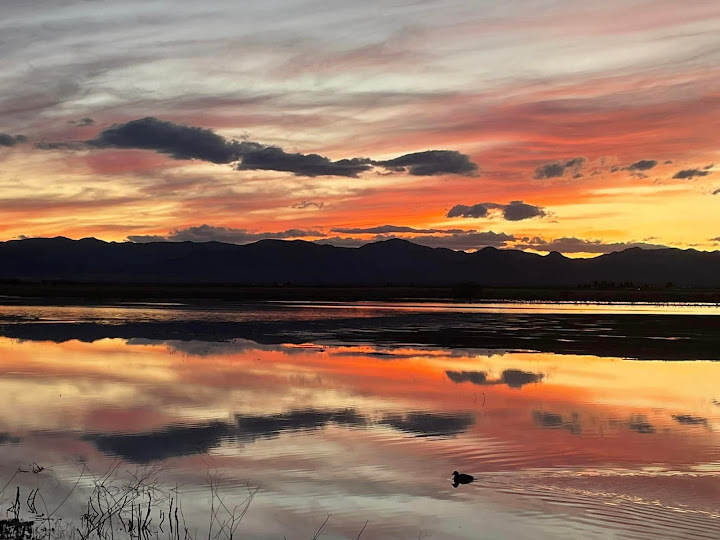February Winds
As February comes to a close, I look back on this month. I didn't think I did as much birding as I did. All I can say is that it has been crazy over here working on various projects so I am grateful that I was able to get some birding in when I did.
Horned Lark-the San Rafael Grasslands
One of my first bird expeditions this month was to help out with Tucson Audubon's Longspur grassland survey. I love love love these birds very much because they are so unique. I went with my friend Hollie Mansfield and her uncle to find longspurs. And boy did we see them!
The trick to finding a longspur in the grasslands is to listen for them around cattle ponds. We were able to pick them out in several spots around our survey area. The Chestnut-collared Longspur is a species that is in decline due to habitat loss. Our job each year here in southeastern Arizona is to make sure we preserve their wintering grounds.
Chestnut-collared Longspur
Another favorite thing to do in January or February is to check out the tens of thousands of Sandhill Cranes that come to winter around water areas in places like Willcox and Bisbee. It's always a beautiful day out.
the Sandhill Cranes of the Whitewater Draw
What was great about this particular weekend was that they descended close to the walking path which made for excellent views.
February is the last BIG month to see the tens of thousands of cranes. Beginning in March through April, these birds begin to head north to their breeding grounds.
It was a lovely day out with my friend Julee as we explored the Whitewater Draw near Bisbee. There were several other large flocks of birds we came to see. Every year, the Snow Geese population has grown larger and larger. So we made the fun challenge of finding Ross's Geese mixed in with the very large Snow Geese Flock.
Snow Geese are doing great with their populations increasing each year around the US and Canada. I'm fairly sure several have made it down into Mexico as well. The conservation efforts have definitely paid off with this species.
We spent the entire day waiting to see several murmurations of birds like the Yellow-headed Blackbirds at night. Thousands flew into the reeds around the ponds and did not disappoint.
Red-tailed Hawk
The sunset was incredible and worth the wait.
Snow Geese have a "smile" or grin patch on their bills. They are also larger with a different head shape.
For a beginning to moderate birder, it can be tough to distinguish the closely related Ross's Goose from the Snow Goose. Both can hybridize. And both like to flock together.
Look at the picture above and below. Notice the head shape, lack of grin on the shorter more triangular bill of the Ross's Goose. Also note that the bill of the Ross's Goose has a bluish base.
I think it's a fun challenge to try picking out a Ross's Goose from the hundreds of Snow Geese. But they have to be close by or it has to be done with a scope. Otherwise, it's nearly impossible to ID the often white distant birds in the farmland.
But with a little patience, it can be done.
The storms have been wonderful this year. And they continue! It is so beautiful. California has been getting pounded by extreme weather. Their storms eventually come over to our state and it has been a very welcome sight! The snow on the mountains has been great!
From left to right. Western Bluebird, Cedar Waxwings and an American Robin
Also great? Thrushes. Everywhere. This year we've seen a huge influx of Cedar Waxwings, Western Bluebirds, Townsend's Solitaires and American Robins. Anyone who has fruit in their yards has had them visit. We have a California Palm with berries and it has been a real treat to have waxwings, robins, bluebirds and solitaires visiting our berries. One morning, before work, I saw a huge flock fly into our palm tree!
Normally tough to find in winter in Tucson, Townsend's Solitaires have been everywhere this year!
A new yard bird this year is the Townsend's Solitaire taken from our courtyard!!! The pic above is from our courtyard.
I've been hanging around local spots like the Tucson Botanical Garden searching for migrating warblers. We had some early Lucy's and Yellow Warblers show up.
As I finish off the month of February, I look forward to the hawk migration in March. We are also planning our first big trip of the year. Nothing is guaranteed, but I'm hoping I'll be able to add a new life bird to library. So stay tuned more for that.
I've been enjoying these cold days and will miss them when they are gone. In March, the days begin to warm up here in southeastern Arizona. There are some exciting treks ahead. I've been researching and planning like crazy.
But I still have a hard time getting out of pj's when I am watching birds at my feeders with my cats and coffee on Saturday morning. It's difficult to have to go to work sometimes:) I'd rather watch it rain and snow outside.
Nebula agrees. Until next time.....



























Comments
Post a Comment